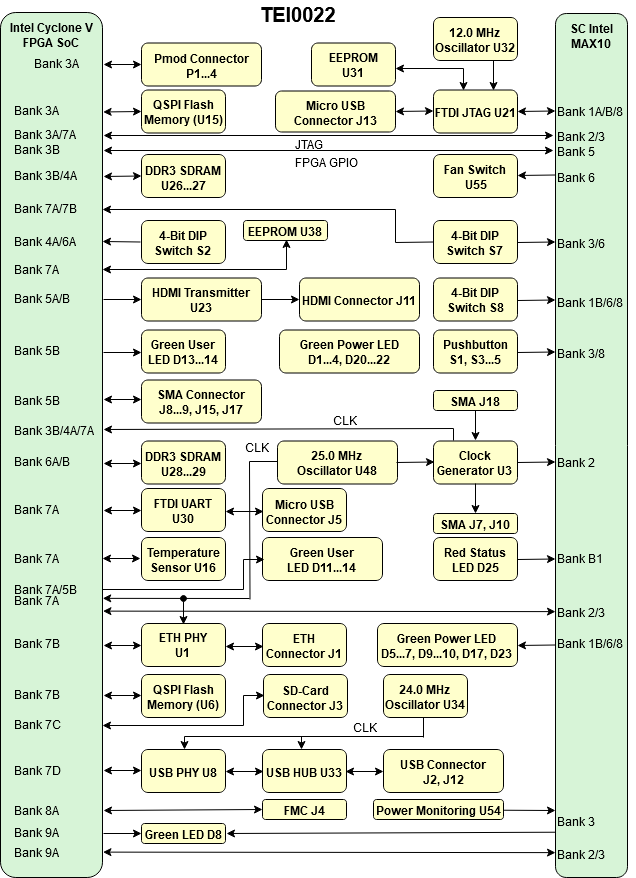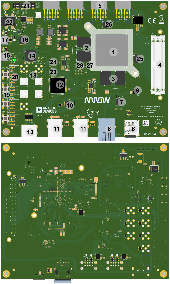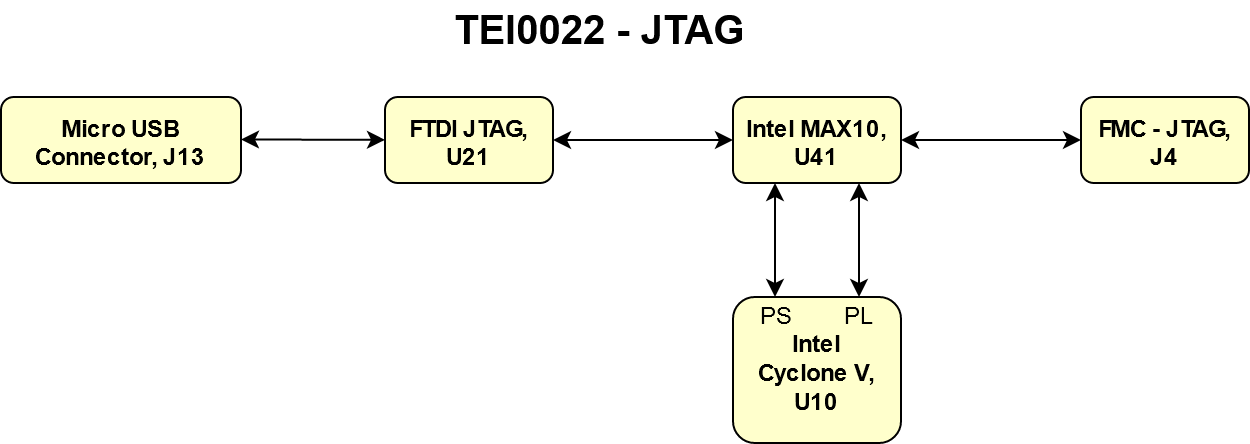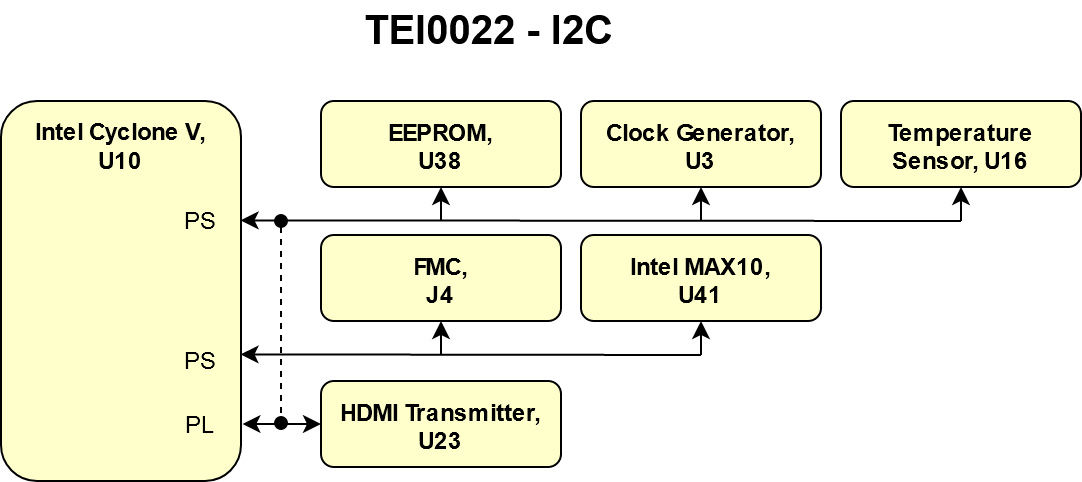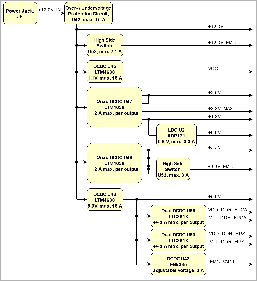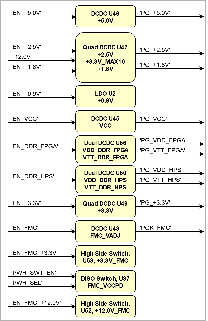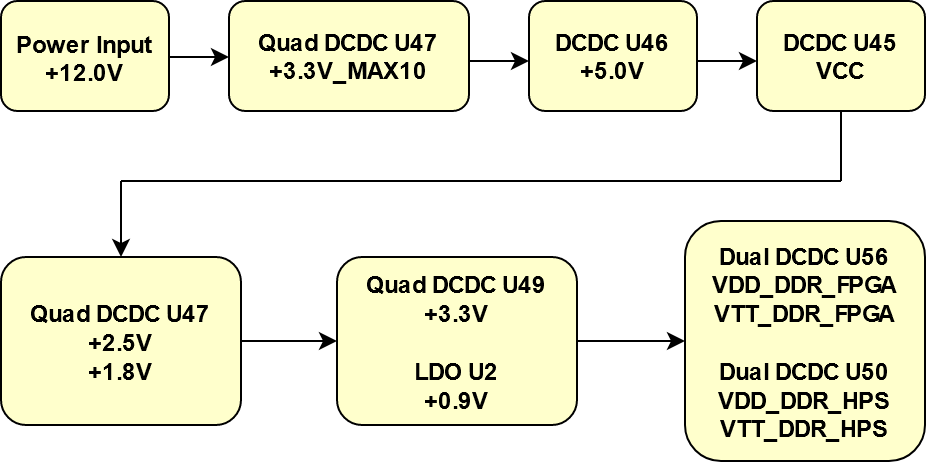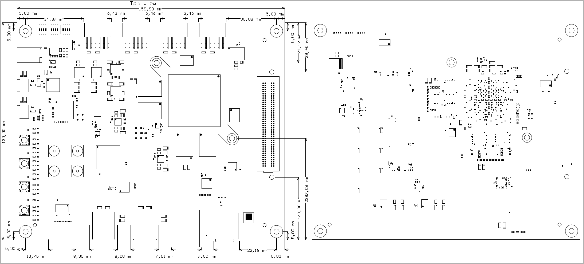Template Revision 2.12
- Module: TRM Name always "TE Series Name" +TRM
Example: "TE0728 TRM" - Carrier: TRM Name usually "TEB Series Name" +TRM
Example: "TEB0728 TRM"
|
<!-- tables have all same width (web max 1200px and pdf full page(640px), flexible width or fix width on menu for single column can be used as before) -->
<style>
.wrapped{
width: 100% !important;
max-width: 1200px !important;
}
</style> |
----------------------------------------------------------------------- |
Note for Download Link of the Scroll ignore macro: |
Table of Contents 
|
Overview
The Trenz Electronic TE0022-01 board is a SoC module based on Intel Cyclone V FPGA, an ethernet PHY, one GByte DDR3 SDRAM and one 32 MByte Quad SPI Flash memory for configuration and operation per HPS and FPGA, and powerful switching-mode power supplies for all on-board voltages.
Refer to http://trenz.org/tei0022-info for the current online version of this manual and other available documentation.
Key Features
Note:
'description: Important components and connector or other Features of the module
→ please sort and indicate assembly options Key Features' must be split into 6 main groups for modues: - SoC/FPGA
- Package:
- Speed:
- Temperature:
- RAM/Storage
- On Board
- Interface
- E.g. ETH, USB, B2B, Display port
- Power
- E.g. Input supply voltage
- Dimension
Key Features' must be split into 6 main groups for carrier: - Modules
- TE0808, TE807, TE0803,...
- RAM/Storage
- On Board
- Interface
- E.g. ETH, USB, B2B, Display port
- Power
- E.g. Input supply voltage
- Dimension
|
- SoC FPGA
- Intel Cyclone V (5CSEMA5F31C8N)
- Package: FBGA 896 pins
- Speed Grade: 8
- Temperature: Commercial (Tj = 0 °C to 85 °C)
- RAM/Storage
- 1 GByte DDR3 SDRAM for HPS
- 1 GByte DDR3 SDRAM for FPGA
- 32 MByte SPI for HPS
- 32 MByte SPI for FPGA
- On Board
- up to 7 x SMA Connector
- Temperature Sensor
- Intel MAX10 for board management
- Interface
- LPC FMC Connector
- 4 x PMOD Connector
- JTAG via micro USB B Connector
- UART via micro USB B Connector
- 4 x USB 2.0
- Ethernet via RJ45 Connector
- SD Card
- HDMI
- Power
- 12 V Input supply voltage
- Dimension
Block Diagram
Main Components
Notes : - Picture of the PCB (top and bottom side) with labels of important components
- Add List below
|
- Intel Cyclone V, U10
- DDR3 SDRAM, U26...27
- DDR3 SDRAM, U28...29
- FMC, J4
- PMOD, P1...4
- SD Card Connector, J3
- Ethernet PHY, U1
- RJ45 Connector, J1
- USB ULPI, U8
- USB HUB, U33
- USB Connector, J2, J12
- HDMI Transmitter, U23
- HDMI Connector, J11
- Intel MAX10, U41
- Micro USB to UART Interface, J5, U30
- USB to JTAG, U21
- Micro USB JTAG, J13
- SMA Connector
- Push Button, S1, S3...5
- LED
- 4-Bit DIP Switch, S2, S7...8
- 12 V Power Jack, J6
- Clock Generator, U48
- Programmable Clock Generator, U3
- QSPI - FPGA PS, U6
- QSPI - FPGA PL, U15
- Temperature Sensor, U16
- EEPROM, U38
Initial Delivery State
Notes : Only components like EEPROM, QSPI flash can be initialized by default at manufacture. If there is no components which might have initial data ( possible on carrier) you must keep the table empty |

Storage device name | Content | Notes |
|---|
HPS SPI Flash (U6) | Not programmed | HPS Configuration | | FPGA SPI Flash (U15) | Not programmed | FPGA Configuration | | MAC EEPROM (U38) | MAC programmed, otherwise not programmed | Ethernet MAC | | FTDI EEPROM (U31) | Programmed | FTDI Functionality |
|
Configuration Signals
- Overview of Boot Mode, Reset, Enables.
|

BOOTSEL[1..0] Signal State | DIP-switch S7 position | Boot Mode | Notes |
|---|
00 | S7A - ON; S7B - ON | FPGA |
| | 01 | S7A - ON; S7B - OFF | SD |
| | 11 | S7A - OFF; S7B - OFF | SPI |
|
|

Reset | Button | Note |
|---|
HPS cold reset | S1 |
| | HPS warm reset | S3 |
| | FPGA reset | S4 |
|
|
Signals, Interfaces and Pins
Notes : - For carrier or stand-alone boards use subsection for every connector type (add designator on description, not on the subsection title), for example:
- For modules which needs carrier use only classes and refer to B2B connector if more than one is used, for example
|
FMC LPC Connector
The FMC (FPGA Mezzanine Card) connector J4 with low pin count (LPC) provides as an ANSI/VITA 57.1 standard a modular interface to the Intel Cyclone V FPGA and exposes numerous of its I/O pins for use by other mezzanine modules and expansion cards.
The connector supports single ended (VCCIO: FMC_VADJ) and differential signaling as the I/O's are routed from the FPGA banks as LVDS-pairs to the FMC connector.
The FMC connector provides further interfaces like JTAG and I²C interfaces:

| Interface | I/O Signal Count | Pin schematic Names / FMC Pins | Connected to | Notes |
|---|
| JTAG | 5 | FMC_TCK, Pin J4-D29 FMC_TMS, Pin J4-D33 FMC_TDI, Pin J4-D30 FMC_TDO, Pin J4- D31 FMC_TRST#, Pin J4- D34 | Intel MAX10 U41, Bank 3 | VCCIO: +3.3V | | I2C | 2 | FMC_SCL, Pin J4-C30 FMC_SDA, Pin J4-C31 | Intel MAX10 U41, Bank 3 and Intel Cyclone V U10, Bank 7A | I2C-lines pulled-up to +3.3V | | Control Lines | 2 | FMC_PRSNT_M2C#, Pin J4-H2 (pulled-up to +3.3V) FMC_PG_C2M, Pin J4-D1 (pulled-up to +3.3V) | Intel MAX10 U41, Bank 3 and Intel Cyclone V U10, Bank 5B | 'PG' = 'Power Good'-signal 'C2M' = carrier to (Mezzanine) module 'M2C' = (Mezzanine) module to carrier |
|
Several VCCIO voltages are available on the FMC connector to operate the I/O's on different voltage levels:

| VCCIO Schematic Name | FMC Connector J4 Pins | Notes |
|---|
| +12.0V_FMC | C35/C37 | extern 12V power supply | | +3.3V_FMC | D36/D38/D40/C39 | 3.3V peripheral supply voltage | | +3.3V | D32 | 3.3V peripheral supply voltage | | FMC_VADJ | H40/G39 | adjustable FMC VCCIO voltage, supplied by DC-DC converter U43 | | FMC_VREF_A_M2C | H1 | adjustable reference voltage |
|
Pmod Connector
The TEI0022 board offers four Pmod (2x6 pins, SMD) connectors which provides as a standard modular interface single ended I/O pins for use with extension modules.
Following table gives an overview of the Pmod connectors and the signals routed to the attached Intel Cyclone V (U10):

| Pmod Connector P1 Pin | Signal Schematic Name | Connected to Intel Cyclone V, U10 | Notes |
|---|
| 1 | P0_IO1 | Pin AD9 |
| | 2 | P0_IO2 | Pin AD11 |
| | 3 | P0_IO3 | Pin AD12 |
| | 4 | P0_IO4 | Pin AC12 |
| | 7 | P0_IO5 | Pin AC9 |
| | 8 | P0_IO6 | Pin AD10 |
| | 9 | P0_IO7 | Pin AA12 |
| | 10 | P0_IO8 | Pin AB12 |
| | Pmod Connector P2 Pin | Signal Schematic Name | Connected to Intel Cyclone V, U10 | Notes | | 1 | P1_IO1 | Pin AG2 |
| | 2 | P1_IO2 | Pin AF4 |
| | 3 | P1_IO3 | Pin AF8 |
| | 4 | P1_IO4 | Pin AD7 |
| | 7 | P1_IO5 | Pin AG1 |
| | 8 | P1_IO6 | Pin AF5 |
| | 9 | P1_IO7 | Pin AE7 |
| | 10 | P1_IO8 | Pin AE9 |
| | Pmod Connector P3 Pin | Signal Schematic Name | Connected to Intel Cyclone V, U10 | Notes | | 1 | P2_IO1 | Pin AH5 |
| | 2 | P2_IO2 | Pin AH3 |
| | 3 | P2_IO3 | Pin AJ2 |
| | 4 | P2_IO4 | Pin AG3 |
| | 7 | P2_IO5 | Pin AG5 |
| | 8 | P2_IO6 | Pin AH4 |
| | 9 | P2_IO7 | Pin AH2 |
| | 10 | P2_IO8 | Pin AJ1 |
| | Pmod Connector P4 Pin | Signal Schematic Name | Connected to Intel Cyclone V, U10 | Notes | | 1 | P3_IO1 | Pin AE12 |
| | 2 | P3_IO2 | Pin AF9 |
| | 3 | P3_IO3 | Pin AG8 |
| | 4 | P3_IO4 | Pin AG6 |
| | 7 | P3_IO5 | Pin AE11 |
| | 8 | P3_IO6 | Pin AF10 |
| | 9 | P3_IO7 | Pin AG7 |
| | 10 | P3_IO8 | Pin AF6 |
|
|
SMA Connector
The TEI0022 board offers up to seven SMA connectors for trigger and clock input and output.

SMA Connector | Signal Schematic Names | Connected to | Notes |
|---|
| J7 | SMA_CLK_OUT_p | Clock Generator U3, Pin 22 | Assembly option | | J10 | SMA_CLK_OUT_n | Clock Generator U3, Pin 21 | Assembly option | | J8 | TRIGGER_OUTPUT | Intel Cyclone V U10, Pin AE29 |
| | J9 | TRIGGER_INPUT | Intel Cyclone V U10, Pin AA26 |
| J15 | EXT_CLK_INPUT | Intel Cyclone V U10, Pin Y26 |
| | J17 | CLK_INPUT | Intel Cyclone V U10, Pin AA26 |
| | J18 | SMA_CLK_IN | Clock Generator U3, Pin 1 | Assembly option |
|
FAN Connector
The TEI0022 board offers one FAN connector for cooling the FPGA device. Depending on the assembly 5 V or 12 V are usable.

Connector | Signal Schematic Names | Connected to | Notes |
|---|
| 2-Pin FAN Connector J16, 5 V or 12 V power supply depending on R270/271 with BTS4141N High Side Switch | FAN_EN, (High Side Switch U55, Pin 3) | Intel MAX10 U41, Pin C1 | Intel Cyclone V cooling FAN |
|
Micro USB Connector (JTAG)
According to the JTAGEN and JTAGSEL[1..0] pins the management Intel MAX10 (U41), the Intel Cyclone V HPS (U10), the Intel Cyclone V FPGA (U10) or the FMC (J4) can be accessed via the micro USB B connector J13.

JTAGSEL1 | JTAGSEL0 | JTAGSEL1 | JTAGSEL0 | Note |
|---|
| X | X | ON | Intel MAX10 |
| | ON | ON | OFF | Intel Cyclone V HPS |
| | ON | OFF | OFF | Intel Cyclone V FPGA |
| | OFF | ON | OFF | FMC |
|
|
Micro USB Connector (UART)
A UART connection between the USB B connector J5 and the Intel Cyclone HPS U10 is possible via the FT234XD (U30) chip.
USB Connector
On the TEI0022 board there are up to four USB 2.0 Hi-Speed ports available (J2, J12).
HDMI Connector
The TEI0022 provides an HDMI Connector.
SD Card Connector
SD Card connector J3 is connected to the Intel Cyclone V.
RJ45 Connector
The board TEI0022 provides an ethernet interface via the RJ45 connector J1.
I2C
The TEI0022 provides three independent I2C busses. One bus is used to connect the FMC I2C with the Intel Cyclone V HPS. The second bus is to connect the HDMI device to the Intel Cyclone V FPGA. The third bus is used to handle the other on-board I2C devices.

| Bus | I2C Device | Designator | I2C Address | Schematic Names of I2C Bus Lines | Notes |
|---|
| HPS I2C | Temperature Sensor | 0x4A | U16 | HPS_I2C_SCL / HPS_I2C_SDA | 3.3 V reference voltage | | HPS I2C | Programmable Clock Generator | 0x70 | U3 | HPS_I2C_SCL / HPS_I2C_SDA | 3.3 V reference voltage | | HPS I2C | EEPROM | 0x50 | U38 | HPS_I2C_SCL / HPS_I2C_SDA | 3.3 V reference voltage | | HDMI I2C | HDMI | 0x72 | U23 | HPS_I2C_SCL / HPS_I2C_SDA | 3.3 V reference voltage | | HPS FMC I2C | FMC | 0x50 | J4 | FMC_SCL / FMC_SDA | 3.3 V reference voltage |
|
On-board Peripherals
Notes : - add subsection for every component which is important for design, for example:
- Two 100 Mbit Ethernet Transciever PHY
- USB PHY
- Programmable Clock Generator
- Oscillators
- eMMCs
- RTC
- FTDI
- ...
- DIP-Switches
- Buttons
- LEDs
|
Notes : In the on-board peripheral table "chip/Interface" must be linked to the corresponding chapter or subsection |
System Controller Intel MAX10
The TEI0022 is equipped with an Intel MAX10 (U41) which is the central system management unit where essential control signals are logically linked by the implemented logic of the FPGA firmware. This generates output signals to control the system, the on-board peripherals and the interfaces. Interfaces like JTAG and buttons between the on-board peripherals and to the FPGA-module are by-passed, forwarded and controlled by the System Controller. Other tasks of the System Controller are the monitoring of the power-on sequence and configuration of the Intel Cyclone V FPGA. The functionalities and configuration of the pins depend on its firmware.
Intel Cyclone V
The on TEI0022 board used Intel Cyclone V device is a SoC with integrated ARM-based HPS. The 5CSEMA5F31C8N version delivers one hard memory controller, 80K logic elements in an FineLineBGA (FBGA) with 896 pins for the commercial temperature range of TJ = 0...85 °C with speed grade eight.
DDR3 SDRAM
Notes : Minimum and Maximum density of DDR3 SDRAM must be mentioned for other assembly options. (pay attention to supported address length for DDR3) |
The TEI0022 SoM has one GByte volatile DDR3 SDRAM memory per FPGA (U26, U27) and HPS (U28, U29) for storing user application code and data.
- Part number: IS43TR16512BL-125KBLI
- Supply voltage: 1.5 V
- Speed: TBD
- Temperature: TC = -40 °C up to 95 °C
Gigabit Ethernet PHY
On-board Gigabit Ethernet PHY (U1) is provided with Analog Devices ADIN1300. The Ethernet PHY RGMII interface is connected to the Intel Cyclone V HPS. I/O voltage is fixed at 3.3 V. The reference clock input of the PHY is supplied from the on-board 25.0 MHz oscillator (U48).

| Bank | Signal Name | Signal Description |
|---|
| 7B | ETH_TXCK | RGMII Transmit Reference Clock | | 7B | ETH_TXD0 | RGMII Transmit Data 0 | | 7B | ETH_TXD1 | RGMII Transmit Data 1 | | 7B | ETH_TXD2 | RGMII Transmit Data 2 | | 7B | ETH_TXD3 | RGMII Transmit Data 3 | | 7B | ETH_TXCTL | RGMII Transmit Control | | 7B | ETH_RXCK | RGMII Receive Reference Clock | | 7B | ETH_RXD0 | RGMII Receive Data 0 | | 7B | ETH_RXD1 | RGMII Receive Data 2 | | 7B | ETH_RXD2 | RGMII Receive Data 3 | | 7B | ETH_RXD3 | RGMII Receive Data 4 | | 7B | ETH_RXCTL | RGMII Receive Control | | 7C | ETH_RST | Reset | | 7B | ETH_MDC | Management Data Clock | | 7B | ETH_MDIO | Management Data I/O | | 7B | PHY_INT | Interrupt |
|
High-Speed USB ULPI PHY
USB PHY (U8) is provided by USB3320C from Microchip. The ULPI interface is connected to the Intel Cyclone V HPS. I/O voltage is fixed at 3.3 V and PHY reference clock input is supplied from the on-board 24.0 MHz oscillator (U34).

| PHY Pin | Connected to | Notes |
|---|
| ULPI | Intel Cyclone V HPS (U10) |
| | REFCLK | 24 MHz from on board oscillator (U34) |
| | REFSEL[0..2] | High (3.3 V) |
| | RESETB | Intel Cyclone V HPS (U10) |
| | DP, DM | 4-port USB 2.0 Hub (U33) |
| | CPEN | Not Connected. |
| | VBUS | Pull-up to 5 V. |
| | ID | Not Connected. |
|
|
4-Port USB 2.0 Hub
On the TEI0022 board there are up to four USB 2.0 Hi-Speed ports available (J2, J12). The USB 2.0 ports are provided by Microchip Cypress USB2514B 4-port USB 2.0 Hub controller (U33) which is connected to the USB PHY USB3320C (U8) connected to the Intel Cyclone V HPS via ULPI.
HDMI Transmitter
The TEI0022 board provides an HDMI interface routed to the Intel Cyclone FPGA (U10). The HDMI interface is created by the HDMI transmitter ADV7511 provided by Analog Devices. The HDMI transmitter is incorporated in conjunction with the HDMI protection circuit TI TPD12S016 for more signal robustness.

| HDMI connector J11 | Signal Schematic Name | Connected to | Notes |
|---|
| Pin 1, 3 | HDMI_TX2_P / HDMI_TX2_N | HDMI transmitter, Pin 43, 42 | also connected to HDMI protection circuit | | Pin 4, 6 | HDMI_TX1_P / HDMI_TX1_N | HDMI transmitter, Pin 40, 39 | also connected to HDMI protection circuit | | Pin 7, 9 | HDMI_TX0_P / HDMI_TX0_N | HDMI transmitter, Pin 36, 35 | also connected to HDMI protection circuit | | Pin 10, 12 | HDMI_TXC_P / HDMI_TXC_N | HDMI transmitter, Pin 33, 32 | also connected to HDMI protection circuit | | Pin 13 | CEC_B | HDMI transmitter, Pin 48 | HDMI CEC, wired through HDMI protection circuit | | Pin 15 | SCL_B | HDMI transmitter, Pin 53 | HDMI I²C clock line, wired through HDMI protection circuit | | Pin 16 | SDA_B | HDMI transmitter, Pin 54 | HDMI I²C data line, wired through HDMI protection circuit | | Pin 19 | HPD_B | HDMI transmitter, Pin 30 | Hot Plug Detect, wired through HDMI protection circuit | | Pin 18 | 5V_HDMI | HDMI protection circuit, Pin 13 | 5V supply voltage, wired through HDMI protection circuit |
|
FTDI (JTAG)
Please refer to the section "Micro USB Connector (JTAG)".
FTDI (UART)
Please refer to the section "Micro USB Connector (UART)".
DIP-Switches
There are three 4-bit DIP-switches present on the TEI0022 board to configure options and set parameters. The following section describes the functionalities of the particular switches.
DIP-Switch S2
The table below describes the functionalities of the switches of DIP-switch S2 at their single positions:

| DIP-switch S2 | Position ON | Position OFF | Notes |
|---|
| S4-1 | HPS_SW1 is low | HPS_SW1 is high | User switch | | S4-2 | HPS_SW2 is low | HPS_SW2 is high | User switch | | S4-3 | FPGA_SW1 is low | FPGA_SW1 is high | User switch | | S4-4 | FPGA_SW2 is low | FPGA_SW2 is high | User switch |
|
DIP-Switch S7
The table below describes the functionalities of the switches of DIP-switch S7 at their single positions:

| DIP-switch S7 | Position ON | Position OFF | Notes |
|---|
| S7-1 | HPS_SPI_SS/BOOTSEL0 is low | HPS_SPI_SS/BOOTSEL0 is high | Boot select (Firnware dependent) | | S7-2 | QSPI_CS/BOOTSEL1 is low | QSPI_CS/BOOTSEL1 is high | Boot select (Firnware dependent) | | S7-3 | JTAGSEL0 is low | JTAGSEL0 is high | JTAG select (Firnware dependent) | | S7-4 | JTAGSEL1 is low | JTAGSEL1 is high | JTAG select (Firnware dependent) |
|
DIP-Switch S8
The table below describes the functionalities of the switches of DIP-switch S8 at their single positions:

| DIP-switch S8 | Position ON | Position OFF | Notes |
|---|
| S8-1 | JTAGEN is high | JTAGEN is low | JTAG select | | S8-2 | VID0_SW is low | VID0_SW is high | FMC_VADJ selection (Firnware dependent) | | S8-3 | VID1_SW is low | VID1_SW is high | FMC_VADJ selection (Firnware dependent) | | S8-4 | VID2_SW is low | VID2_SW is high | FMC_VADJ selection (Firnware dependent) |
|
Buttons
There are four buttons present on the TEI0022 board. The following section describes the functionalities of the particular buttons. The final functionality is set by the management Intel MAX10.

| Button | Position ON | Position OFF | Notes |
|---|
| S1 | HPS_RST#_SW is high | HPS_RST#_SW is low | Reset (cold) the Intel Cyclone V HPS (Firnware dependent) | | S3 | HPS_WARM_RST#_SW is high | HPS_WARM_RST#_SW is low | Reset (warm) the Intel Cyclone V HPS (Firnware dependent) | | S4 | FPGA_RST#_SW is high | FPGA_RST#_SW is low | Reset the Intel Cyclone V FPGA (Firnware dependent) | | S5 | USER_BTN_SW is high | USER_BTN_SW is low | User button (Firnware dependent) |
|
On-Board LEDs
The TEI0022 board is equipped with several LEDs to signal current states and activities. The functionality of the LEDs D11...14 are user LEDs. The LED D8 shows the Intel Cyclone V configuration progress. LEDs D15, D18...19 shows the UART connection and the other LEDs mentioned in the table are supply power status LEDs.

| Designator | Color | Connected to | Active Level | Note |
|---|
| D11 | Green | Intel Cyclone V HPS | L | User LED | | D12 | Green | Intel Cyclone V HPS | L | User LED | | D13 | Green | Intel Cyclone V FPGA | L | User LED | | D14 | Green | Intel Cyclone V FPGA | L | User LED | | D8 | Green | Intel Cyclone V FPGA | L | Status: Configuration "Done" | | D15 | Green | FT234XD | L | UART | | D18 | Green | UART TX | H | UART | | D19 | Green | UART RX | H | UART | | D21 | Green | +12.0V | H | Status of +12.0V voltage rail | | D1 | Green | +12.0V_FMC | H | Status of +12.0V_FMC voltage rail | | D2 | Green | +5.0V | H | Status of +5.0V voltage rail | | D3 | Green | +3.3V | H | Status of +3.3V voltage rail | | D20 | Green | +3.3V_MAX10 | H | Status of +3.3V_MAX10 voltage rail | | D22 | Green | +3.3V_FMC | H | Status of +3.3V_FMC voltage rail | | D4 | Green | +2.5V | H | Status of +2.5V voltage rail | | D5 | Green | +1.8V | H | Status of +1.8V voltage rail | | D7 | Green | VCC | H | Status of VCC voltage rail | | D9 | Green | FMC_VADJ | H | Status of FMC_VADJ voltage rail | | D6 | Green | VDD_DDR_FPGA | H | Status of VDD_DDR_FPGA voltage rail | | D23 | Green | VDD_DDR_HPS | H | Status of VDD_DDR_HPS voltage rail | | D17 | Green | VTT_DDR_FPGA | H | Status of VTT_DDR_FPGA voltage rail | | D10 | Green | VTT_DDR_HPS | H | Status of VTT_DDR_HPS voltage rail | | D25 | Green | Intel Cyclone V HPS U10, Pin B23 | L | Status of the daughterboard identification |
|
Temperatur Sensor
The temperature sensor ADT7410 (U16) is implemented on the TEI0022 board.
Quad SPI Flash Memory
Notes : Minimum and Maximum density of quad SPI flash must be mentioned for other assembly options. |
Two 256 Mbit (32 MByte) Quad SPI Flash Memory (Micron MT25QL256ABA8E12, U6, U15) are provided for FPGA and HPS configuration file storage. After configuration process completes the remaining free memory can be used for application data storage. All four SPI data lines are connected to the FPGA or the HPS allowing x1, x2 or x4 data bus widths to be used. The maximum data transfer rate depends on the bus width and clock frequency.
Quad SPI Flash memory U6 is connected to the HPS bank 7B and U15 to FPGA bank 3A.

| Signal Name | QSPI Flash Memory U6 Pin | FPGA Pin |
|---|
| QSPI_CS/BOOTSEL1 | S#, Pin C2 | Bank 7B, Pin A18 | | QSPI_CLK | C, Pin B2 | Bank 7B, Pin D19 | | QSPI_DATA0 | DQ0, Pin D3 | Bank 7B, Pin C20 | | QSPI_DATA1 | DQ1, Pin D2 | Bank 7B, Pin H18 | | QSPI_DATA2 | DQ2, Pin C4 | Bank 7B, Pin A19 | | QSPI_DATA3 | DQ3, Pin D4 | Bank 7B, Pin E19 | | QSPI_RST | RST#, Pin A4 | Bank 7A, Pin E24 |
|

| Signal Name | QSPI Flash Memory U15 Pin | FPGA Pin |
|---|
| nCSO | S#, Pin C2 | Bank 3A, Pin AB8 | | AS_DCK | C, Pin B2 | Bank 3A, Pin U7 | | AS_DATA0 | DQ0, Pin D3 | Bank 3A, Pin AE6 | | AS_DATA1 | DQ1, Pin D2 | Bank 3A, Pin AE5 | | AS_DATA2 | DQ2, Pin C4 | Bank 3A, Pin AE8 | | AS_DATA3 | DQ3, Pin D4 | Bank 3A, Pin AC7 | | AS_RST | RST#, Pin A4 | Bank 7A, Pin B22 |
|
EEPROM
The TEI0022 board contains two EEPROMs for configuration and general user purposes.

| EEPROM Model | I2C Address | Designator | Memory Density | Purpose | Notes |
|---|
| 24AA025E48T-I/OT | 0x50 | U38 | 2 KBit | Ethernet MAC |
| | 93AA56BT-I/OT | - | U31 | 2 KBit | JTAG Configuration |
|
|
Clock Sources
The FPGA module has following reference clocking source provided by an on-board oscillator:

| Clock Source | Frequency | Signal Schematic Name | Clock Destination | Notes |
|---|
U48, SiT8208AI
| 25.0 MHz
| CLK_25MHz_R
| Si5338A PLL U3, Pin 3 (IN3) |
| | HPS_CLK1_25MHz | HPS Bank 7A U10, Pin D25 |
| | ETH_XTAL_IN | ETH PHY U1, Pin 9 |
| | U32, SiT8208AI | 12.0 MHz | OSCI | FT2232H U21, Pin 3 |
| | U34, SiT8008BI | 24.0 MHz | USB_CLK24_HUB | USB Hub U33, Pin 33 |
|
|
| USB_CLK24_PHY | USB PHY U8, Pin 26 |
|
|
Programmable Clock Generator
There is a Silicon Labs I2C programmable quad PLL clock generator on-board (Si5338A, U3) to generate various reference clocks for the module.

| Si5338A Pin | Signal Name / Description | Connected to | Direction | Notes |
|---|
IN1 | SMA_CLK_IN | SMA J18, Pin 1 | Input | Assembly option dependent | | IN2 | SMA_CLK_IN | SMA J18, Pin 2 | Input | Assembly option dependent | IN3 | Reference input clock | U48, Pin 3 | Input | 25 MHz oscillator U48, SiT8208 | IN4 | - | GND | Input | I2C slave device address LSB | IN5 | - | Not Connected | Input | Not used | | IN6 | - | GND | Input | Not used | | SCL | HPS_I2C_SCL | HPS I2C Bus U10, Pin H23 | Input | I²C interface muxed to Intel Cyclone V Slave address: 0x70. | | SDA | HPS_I2C_SDA | HPS I2C Bus U10, Pin A25 | Input / Output | I²C interface muxed to Intel Cyclone V Slave address: 0x70. | CLK0A/B | SMA_CLK_OUT_p/n | SMA J7/J10 | Output | Clock to SMA connectors (Assembly option dependent) | CLK1A/B | CLK_B3B_p/n | U10, Pin AF14/15 |
| Clock to FPGA bank 3B | | CLK2A | CLK_50MHz_MAX10 | U41, Pin H6 | Output | Clock to Intel MAX10 bank 2 | | CLK2B | HPS_CLK2_25MHz | U10, Pin F25 | Output | Clock to HPS bank 7A | | CLK3A/B | CLK_B4A_p/n | U10, Pin AA16/AB17 | Output | Clock to FPGA bank 4A |
|
Power Monitoring
The TEI0022 uses a precision supply monitor (U54) for three voltages. Therefore if one of the voltages browns out it should be realized and handled.
Power and Power-On Sequence
In 'Power and Power-on Sequence' section there are three important digrams which must be drawn: - Power on-sequence
- Power distribution
- Voltage monitoring circuit
|
Power Supply
The maximum power consumption of this board mainly depends on the design which is running on the FPGA. Intel provides a power estimator excel sheets to calculate power consumption.
Power Consumption

| Power Input Pin | Typical Current |
|---|
| +12.0V_IN | TBD* |
|
* TBD - To Be Determined
Power Distribution Dependencies
All on-board voltages of the TEI0022 are generated out of the extern applied 12 V power supply.
There are following dependencies how the initial 12V power supply is distributed to the on-board DC-DC converters, which power up further DCDC converters and the particular on-board voltages:
Power-On Sequence
The following figures delivers the power-on sequence information. The figure Power Sequency shows the connections between the power devices and its management. The figure Suggested Power Sequency shows the recommended firmware power-on sequence.
Voltage Monitor Circuit
The voltages +3.3V, +5.0V, and VCC are monitored by the voltage monitor circuit LTC2911 (U54), which generates a reset signal at power-on. A manual reset is also possible as described in the reset table.
Bank Voltages

| Schematic Name | | Notes |
|---|
| Bank 3A | +3.3V | +3.3 V |
| | Bank 3B | VDD_DDR_FPGA | +1.5 V |
| | Bank 4A | VDD_DDR_FPGA | +1.5 V |
| | Bank 5A | +3.3V | +3.3 V |
| | Bank 5B | +3.3V | +3.3 V |
| | Bank 6A | VDD_DDR_HPS | +1.5 V |
| | Bank 6B | VDD_DDR_HPS | +1.5 V |
| | Bank 7A | +3.3V | +3.3 V |
| | Bank 7B | +3.3V | +3.3 V |
| | Bank 7C | +3.3V | +3.3 V |
| | Bank 7D | +3.3V | +3.3 V |
| | Bank 8A | FMC_VADJ | +3.3 V, +2.5 V, +1.8 V, +1.25 V, +1.2 V | Adjustable voltage (+0.8 V is not usable at the Intel Cyclone V) | | Bank 9A | +3.3V | +3.3 V |
|
|
Technical Specifications
Absolute Maximum Ratings

| Symbols | Description | Min | Max | Unit |
|---|
| +12.0V_IN | Input Voltage | -40 | 60 | V |
|
Recommended Operating Conditions
Operating temperature range depends also on customer design and cooling solution. Please contact us for options.

| Parameter | Min | Max | Units | Reference Document |
|---|
| +12.0V_IN | 10.5 | 13 | V | Input power protection U42 |
|
Physical Dimensions
PCB thickness: 1.9 mm.
Currently Offered Variants
Revision History
Hardware Revision History

| Date | Revision | Changes | Documentation Link |
|---|
| - | 01 | First Production Release |
|
|
Hardware revision number can be found on the PCB board together with the module model number separated by the dash.
Document Change History
- Note this list must be only updated, if the document is online on public doc!
- It's semi automatically, so do following
Add new row below first Copy "Page Information Macro(date)" Macro-Preview, Metadata Version number, Author Name and description to the empty row. Important Revision number must be the same as the Wiki document revision number Update Metadata = "Page Information Macro (current-version)" Preview+1 and add Author and change description. --> this point is will be deleted on newer pdf export template - Metadata is only used of compatibility of older exports
|

| Date | Revision | Contributor | Description |
|---|
| | 
| | -- | all | 
| |
|
Disclaimer


